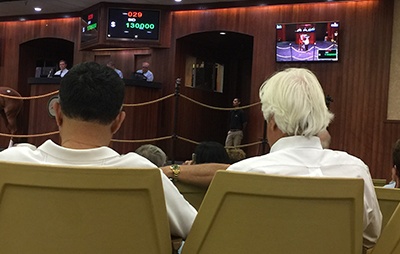
Thank you for all the nice comments about the sales blog. The sales auction is a huge part of the industry and your excitement to learn more about the process is nice to see. For thoroughbred partnerships, these sales are the main settings for stocking up the barn for the coming year. Buying the right horse at the right price is what your partners demand and either you deliver, or they will find someone else who will.
Day 1 of the OBS March sale is in the books. Overall, thus far, the sale is a tad behind last year. OBS reported 160 juveniles sold for a total $25,718,500, down 16.2% compared with $30,704,000 total for 169 head for the first session in 2015. The average fell 11.5% from $181,680 to $160,741; this year’s median was $115,000, compared with $120,000 a year ago. The buyback percentage was 28.9%; it was 20.6% in 2015. Since it’s a two day sale with a random draw determining order, we will save our market analysis until the full results are in.
What we did see was a continued trend of the big buyers (that’s Bob Baffert trying to be stealth) purchasing the top tier horses leaving the middle market flat. Being a mid-ranger, buying a horse in this market is extremely tough. Consignors place home run reserves on their horses and when they fall outside the big buyers, instead of selling to us, they bring them home for another day. I never judge a seller if they place a high reserve. It’s their horse, they can sell it for whatever they want. If I really like a horse, after learning that the horse is RNA (ie reserve not met) I may approach the consignor afterwards and make an offer at our price. Sometimes the seller has a change of heart and sometimes they don’t. You can see which horses were sold this way (ie “immediately after the sale”) on the OBS site. They are marked PS. One of LRF’s best horses, Bellamentary, was purchased last year under this set of circumstances. Thankfully, the reserve was not met that day.
Overall, auction day is an exhilarating experience and today was no different. Just when you think all of the hard work is over, really it is just beginning as you now compete against your fellow owners. A huge initial decision to make is lining up your selections (the LRF short list has 8 horses). Do you pass on a horse early in the sale because better is waiting? At an auction, without knowing the price of any of your other selections, you need to make split second decisions on the first ones in front of you. It isn’t fun watching a horse you place a $100k value at sitting at $105k to one of your competitors. Pride (this horse is mine!), insecurity (maybe he’s worth more than I thought!) and being shut out (discussed below) all flow through your head and you have seconds to make another bid. If it’s at the end of a sale and you haven’t made a purchase, you may bid another $10k.
Today, LRF looked very closely at Hips 60, and 180. Hip 60 is a Congrats colt with a pedigree that included Hard Spun. I loved him for the marketing angle, but as a horse we liked others a little better so we passed. Hip #60 went RNA for $70k, right in our wheel house. If this was the last horse in the sale and we hadn’t purchased anything, I would’ve for sure probably bid up to $100k. But we chose to sit back and wait for others. When you whittle 600 horses down to 8 sometimes you have to trust that the other 7 will prove fruitful. The grass is always greener, right? Unfortunately, today it was not. We waited for Hip #180 and the filly went for $160k, just outside our budget for this horse.
This brings up one of the biggest misconceptions about auctions. People look at the final prices and say OH I COULD’VE HAD THAT HORSE FOR ANOTHER $5K. Wrong. If you were at the auction you could’ve bid $5k more….but you have no idea how high the buyers “final number” was. Many sales we walk away with a horse for $75k when we would’ve paid $200k. People believe the final price is also the market price. In truth, the hammer price is solely the price one buyer paid (and one seller sold for) at that particular time. If you think about it, that shrinks “market price” to a private transaction between two individuals.
Good night from Ocala. Here’s to a great day tomorrow with our remaining six “short list” prospects.
